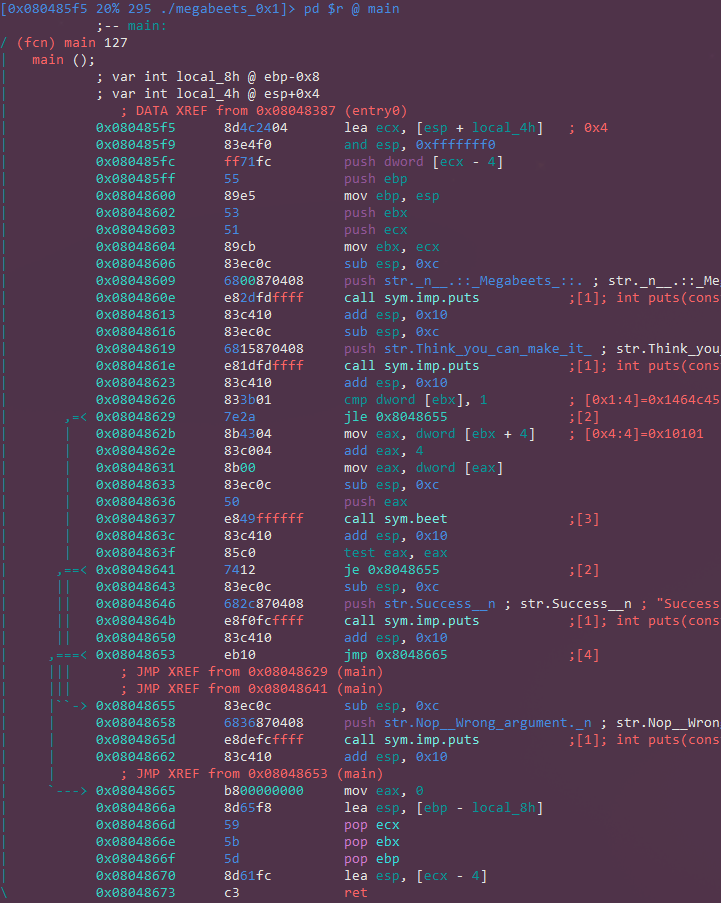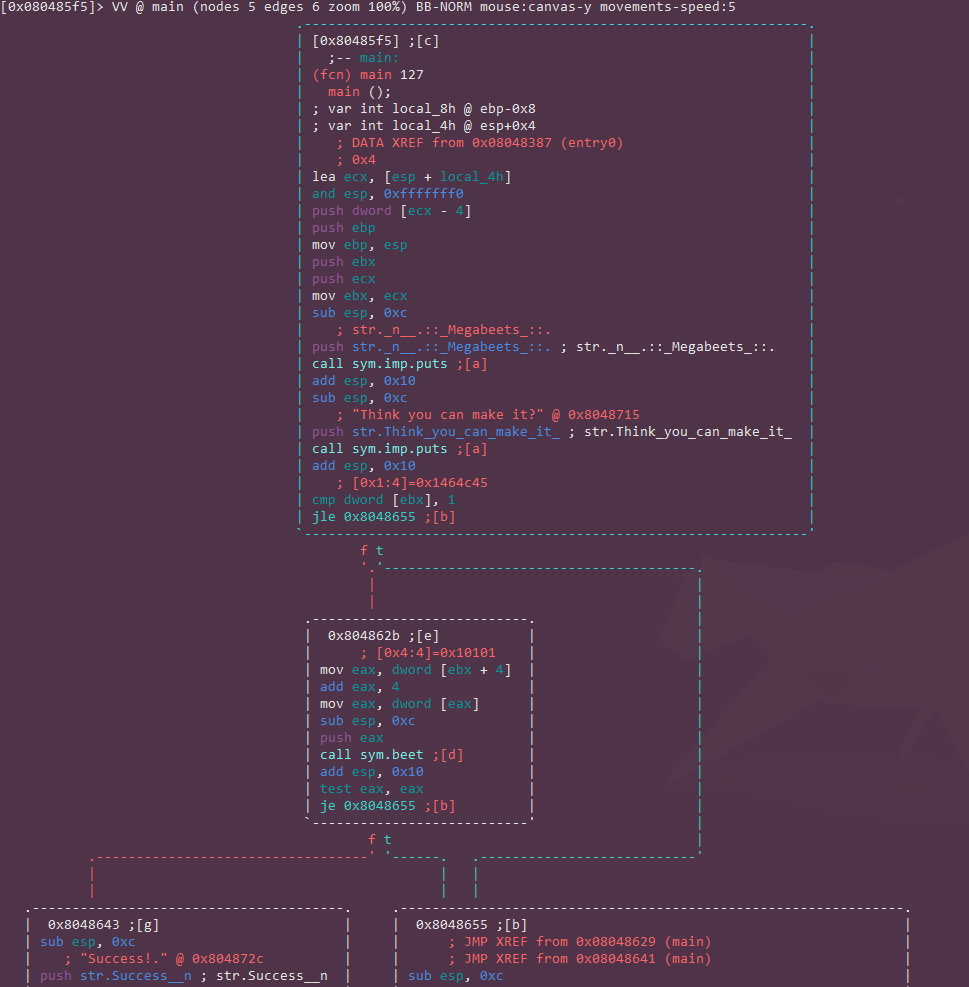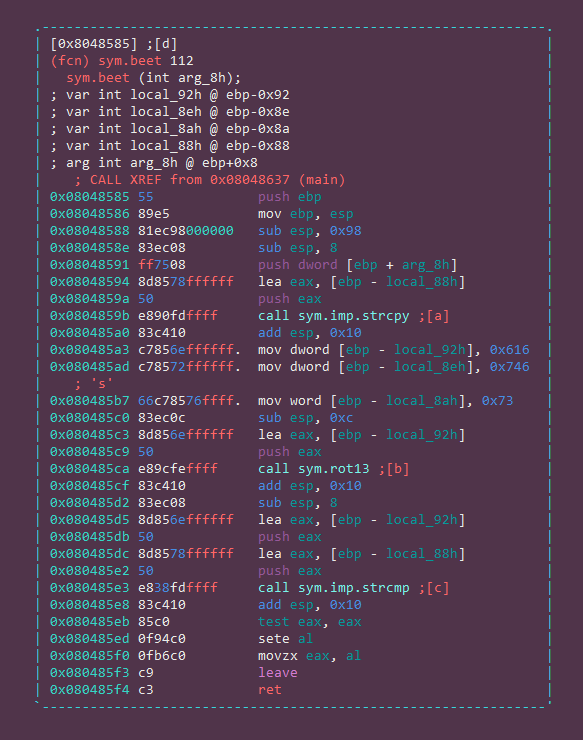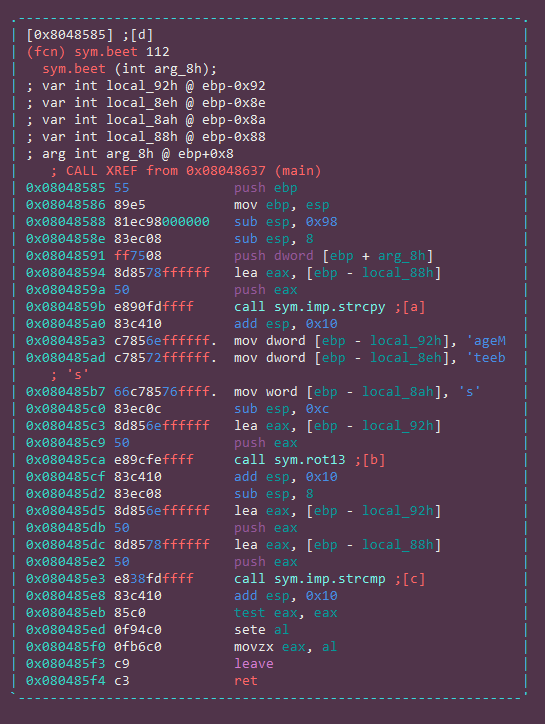翻译自Megabeets。
序言
过去一年里的 CTF 比赛中,不论是逆向工程(RE)还是漏洞挖掘(PWN),我一直在用radare2。我发现radare2对于很多 CTF 的题目来说都很有用,极大地缩短了我的做题时间。遗憾的是熟悉 radare2 的人太少了。可能大家都习惯了使用IDA Pro、OllyDBG还有gdb,或者没有听说过它。不管怎么样,我都认为radare2应该成为你工具箱中的一部分。
因为我真的特别喜欢这个项目,而且我希望能有越来越多的人开始熟悉它、使用它,能对项目做出一些贡献。我计划写一系列的文章以及使用r2的例子。因为那些文章都涉及radare2的特点和功能,我会解释的更加详细。

radare2
radare2是一个逆向工程和二进制分析的开源框架,它有很多命令行接口,包括反汇编、分析数据、打补丁、比较数据、查找、替换、可视化等等功能。同时它可以在几乎所有的主要操作系统(GNU/Linux、.Windows、*BSD、iOS、OSX、Solaris等等)上运行,并且支持许多 CPU 架构和文件格式。他所有的特点可以展现出一个思想——radare2是绝对自由的。
该框架是一个工具的集合,既可以在r2给出的 shell 下使用,又可以独立使用——比如我们将要了解的rahash2、rabin2、ragg2三个组件。所有的组件赋予了radare2强大的静态或动态分析、十六进制编辑以及漏洞挖掘能力(在接下来的文章中我会更深入地讲述)。
我们必须意识到学习r2是一个十分艰难的过程——虽然r2有 GUI 和 WebUI。在我看来,IDA 的 GUI 和方便性确实更佳。但是它的命令行接口,包括其可视化模式,仍然是radare2的核心以及魅力所在。因为它的复杂性,我会尽力讲得浅显易懂。

在开始之前,你可以看一看“r2、IDA Pro 和 Hopper 等工具间的比较”来了解它。
获取radare2
下载
radare2的环境配置非常快——我们每天都会更新,所以更推荐你去使用 git 的版本,而不是稳定版本。有时候稳定版本可能没有 git 版本更稳定。
$ git clone https://github.com/radare/radare2.git
$ cd radare2
$ ./sys/install.sh
如果你不想下载 git 版本或者你想要不同操作系统(Windows、OS X、iOS等等)上的可执行文件,可以在radare2 官网下载界面查看。
更新
正如我之前所说的,更推荐大家使用 git 仓库里最新版的r2。从 git 更新r2只需要执行:
$ ./sys/install.sh
然后你就能从 git 获得最新的版本。我通常每天早上会更新一下radare2,在这期间可以看看一会儿视频消遣。
卸载
我实在想不出什么理由会让你在看这篇文章时想要卸载radare2。如果要卸载的话只需要执行:
$ make uninstall
$ make purge
开始学习
你可以在这里下载 Crackme。
现在你已经在自己的系统上下载了radare2和文件,我们可以开始探索radare2的基础使用。我会在REMunx上调试,大部分的命令和说明跟Windows或者其他系统上是一样的。
命令行参数
和大部分命令行工具一样,查看可选参数的方式是执行-h参数:
$ r2 -h
我不把完整的输出放上来,而是放一些我日常工作中常用的参数:
Usage: r2 [-ACdfLMnNqStuvwz] [-P patch] [-p prj] [-a arch] [-b bits] [-i file]
[-s addr] [-B baddr] [-M maddr] [-c cmd] [-e k=v] file|pid|-|--|=
-d: Debug the executable 'file' or running process 'pid'
-A: Analyze executable at load time (xrefs, etc)
-q: Quiet mode, exit after processing commands
-w: Write mode enabled
-L: List of supported IO plugins
-i [file]: Interprets a r2 script
-n: Bare load. Do not load executable info as the entrypoint
-c 'command; command; ...': Run r2 and execute commands (eg: r2 's main; px 60')
-p [prj]: Creates a project for the file being analyzed
-: Opens r2 with the malloc plugin that gives a 512 bytes memory area to play with
二进制信息
面对一个新的文件时,我第一件想做的事就是获取文件的信息。我们可以使用r2框架中最强大的工具之一——rabin2来获取信息。
rabin2可以从二进制文件中获取信息,包括区段、文件头、导入导出表、字符串、入口点等等。同时具有不同的格式的输出。rabin2支持ELF、PE、Mach-O、Java CLASS等文件。使用
man rabin2查看更多的信息。
我们执行rabin2并使用参数-I输出二进制信息,例如操作系统、语言、字节序、框架以及保护技术(比如Canary、PIC、NX)等等。
$ rabin2 -I megabeets_0x1
havecode true
pic false
canary false
nx false
crypto false
va true
intrp /lib/ld-linux.so.2
bintype elf
class ELF32
lang c
arch x86
bits 32
machine Intel 80386
os linux
minopsz 1
maxopsz 16
pcalign 0
subsys linux
endian little
stripped false
static false
linenum true
lsyms true
relocs true
rpath NONE
binsz 6220
你可以清楚地看到,这是一个 32 位 elf 文件,没有符号表并且是动态链接。它没有任何漏洞利用技术——下一篇文章我们讲学习使用radare2来对漏洞进行利用。
让我们跑一下程序,看看它做了什么。
- 注意:虽然我可以向你保证这个程序是安全的,但是逆向一个未知的程序时,务必在一个虚拟环境下运行。
- 不过你可以相信我,因为程序确实是安全的。😛
$ ./megabeets_0x1
.:: Megabeets ::.
Think you can make it?
Nop, Wrong argument.
$ ./megabeets_0x1 abcdef
.:: Megabeets ::.
Think you can make it?
Nop, Wrong argument.
第一次跑的时候,输出了Nop, Wrong argument。假设我们需要提供一个参数,第二次输入abcdef作为参数,依旧失败了。显然需要特定的字符串才能绕过。
让我们用radare2来测试程序:
$ r2 ./megabeets_0x1
— Thank you for using radare2. Have a nice night!
[0x08048370]>
我们生成了一个radare2的 shell,还有一个欢迎界面。我们可以执行fo来输出一个新的句子,有些很搞笑同时有些也很有趣。现在r2的 shell 正在等着我们输入命令,并且展示给我们此刻所在的地址(0x08048370)。默认情况下我们自动在入口点处。让我们看看是否正确:
[0x08048370]> ie
[Entrypoints]
vaddr=0x08048370 paddr=0x00000370 baddr=0x08048000 laddr=0x00000000 haddr=0x00000018 type=program1 entrypoints
我们使用ie命令输出了文件的入口点地址。r2命令有一系列有意义的字母。在这个例子里,ie代表了info >> entrypoint。因此在你熟悉了radare2的能力之后,命令都是比较好记的。但是你不需要记住所有的命令——你可以仅仅需要在(几乎)每个字母后面加上?来获得命令的信息以及它的子命令。
[0x08048370]> i?
|Usage: i Get info from opened file (see rabin2’s manpage)
| Output mode:
| ‘*’ Output in radare commands
| ‘j’ Output in json
| ‘q’ Simple quiet output
| Actions:
| i|ij Show info of current file (in JSON)
| iA List archs
| ia Show all info (imports, exports, sections..)
| ib Reload the current buffer for setting of the bin (use once only)
| ic List classes, methods and fields
| iC Show signature info (entitlements, …)
| id Debug information (source lines)
| iD lang sym demangle symbolname for given language
| ie Entrypoint
| iE Exports (global symbols)
| ih Headers (alias for iH)
| iHH Verbose Headers in raw text
| ii Imports
| iI Binary info
| ik [query] Key-value database from RBinObject
| il Libraries
| iL List all RBin plugins loaded
| im Show info about predefined memory allocation
| iM Show main address
| io [file] Load info from file (or last opened) use bin.baddr
| ir|iR Relocs
| is Symbols
| iS [entropy,sha1] Sections (choose which hash algorithm to use)
| iV Display file version info
| iz Strings in data sections
| izz Search for Strings in the whole binary
| iZ Guess size of binary program
i命令目的是从打开的文件中获取信息,它就是集成到radare2的 shell 里的rabin2(之前提到的)。
分析
默认情况下radare2不会自动分析文件,因为分析文件是一个复杂的过程,尤其是比较大的文件。了解更多关于分析的内容,你可以看一看在radare2博客上的这篇文章。
显然分析仍然是可能的,r2提供了许多种类的分析方式。正如我之前提到的,我们可以通过对a命令后面添加?来查找分析选项。
[0x08048370]> a?
|Usage: a[abdefFghoprxstc] […]
| ab [hexpairs] analyze bytes
| abb [len] analyze N basic blocks in [len] (section.size by default)
| aa[?] analyze all (fcns + bbs) (aa0 to avoid sub renaming)
| ac[?] [cycles] analyze which op could be executed in [cycles]
| ad[?] analyze data trampoline (wip)
| ad [from] [to] analyze data pointers to (from-to)
| ae[?] [expr] analyze opcode eval expression (see ao)
| af[?] analyze Functions
| aF same as above, but using anal.depth=1
| ag[?] [options] output Graphviz code
| ah[?] analysis hints (force opcode size, …)
| ai [addr] address information (show perms, stack, heap, …)
| ao[?] [len] analyze Opcodes (or emulate it)
| aO Analyze N instructions in M bytes
| ar[?] like ‘dr’ but for the esil vm. (registers)
| ap find prelude for current offset
| ax[?] manage refs/xrefs (see also afx?)
| as[?] [num] analyze syscall using dbg.reg
| at[?] [.] analyze execution traces
Examples:
f ts @ S*~text:0[3]; f t @ section..text
f ds @ S*~data:0[3]; f d @ section..data
.ad t t+ts @ d:ds
我通常开始分析时会执行aa(analyse all)。这个名称有一点容易误解,因为除此之外还有很多可以分析的(执行aa?可以看到更多的用法),但对于这个程序来说已经足够了。这次我们直接执行aaa,更简单些。你也可以执行radare2用-A参数来分析文件,直接在开始就执行aaa(例如r2 -A megabeets_0x1)
[0x08048370]> aaa
[x] Analyze all flags starting with sym. and entry0 (aa)
[x] Analyze len bytes of instructions for references (aar)
[x] Analyze function calls (aac)
[*] Use -AA or aaaa to perform additional experimental analysis.
[x] Constructing a function name for fcn.* and sym.func.* functions (aan)
标志
在分析之后,radare2把一些特定的名字和偏移联系在一起,例如区段、函数、符号表、字符串等等。他们被称作为标志。标志被整合进标志空间,一个标志空间是所有类似特征的标志的集合。执行fs以查看所有的标志:
[0x08048370]> fs
0 4 . strings
1 35 . symbols
2 82 . sections
3 5 . relocs
4 5 . imports
5 1 . functions
我们可以使用fs <flagspace>来查看某个特定的标志空间,然后用f输出所有的标志。我们使用分号将一行中的多个命令分开(比如命令一; 命令二; 命令三;...)。
[0x08048370]> fs imports; f
0x08048320 6 sym.imp.strcmp
0x08048330 6 sym.imp.strcpy
0x08048340 6 sym.imp.puts
0xffffffff 16 loc.imp.__gmon_start__
0x08048350 6 sym.imp.__libc_start_main
正如我们所看到的,radare2将所有程序所使用的导入表输出——可以看到我们所熟悉的strcmp、strcpy、puts等,包括相关的地址。我们也可以列出字符串的标志空间。
[0x08048370]> fs strings; f
0x08048700 21 str._n__.::_Megabeets_::.
0x08048715 23 str.Think_you_can_make_it_
0x0804872c 10 str.Success__n
0x08048736 22 str.Nop__Wrong_argument._n
字符串
我们看到r2列出了一些字符串的偏移,还有一些变量名。让我们主要来看看字符串。有很多可以列出程序中字符串的方式,你可以选择你最需要的一种。iz – 列出在数据短的字符串izz – 在整个程序中查找字符串
[0x08048370]> iz
vaddr=0x08048700 paddr=0x00000700 ordinal=000 sz=21 len=20 section=.rodata type=ascii string=\n .:: Megabeets ::.
vaddr=0x08048715 paddr=0x00000715 ordinal=001 sz=23 len=22 section=.rodata type=ascii string=Think you can make it?
vaddr=0x0804872c paddr=0x0000072c ordinal=002 sz=10 len=9 section=.rodata type=ascii string=Success!\n
vaddr=0x08048736 paddr=0x00000736 ordinal=003 sz=22 len=21 section=.rodata type=ascii string=Nop, Wrong argument.\n
我们已经熟悉了大部分字符串——还记得我们一开始运行程序时的那几行字符串吧。但是我们没有看到Success,这应该是我们输入正确字符串后的提示。既然我们已经得到了字符串,让我们看看它们在程序的什么地方被使用了。
[0x08048370]> axt @@ str.*
data 0x8048609 push str._n__.::_Megabeets_::. in main
data 0x8048619 push str.Think_you_can_make_it_ in main
data 0x8048646 push str._n_tSuccess__n in main
data 0x8048658 push str._n_tNop__Wrong_argument._n in main
这个命令展示给我们radare2更多的特点。axt命令用来在数据段或程序段交叉查找某个地址(试试ax?)。@@是一个迭代器标志,用来在一段偏移上重复某个命令(试试@@?)。str.*是一个对所有开头为str.的标志的通配。这条命令能帮助我列出字符串标志以及对应所在的函数名。在这之前要确保选择了字符串的标志空间(默认时是fs *)。
定位
正如我之前所说的,之前我们一直在程序的入口点,现在应该去其他地方看看了。我们刚列出来的字符串都是在main函数中的。为了定位到字符串,我们需要使用seek命令,用s替代。正如大家所知道的,在(几乎)每个命令后加上?会解决你所有的问题。
[0x08048370]> s?
|Usage: s # Seek commands
| s Print current address
| s addr Seek to address
| s- Undo seek
| s- n Seek n bytes backward
| s– Seek blocksize bytes backward
| s+ Redo seek
| s+ n Seek n bytes forward
| s++ Seek blocksize bytes forward
| s[j*=] List undo seek history (JSON, =list, *r2)
| s/ DATA Search for next occurrence of ‘DATA’
| s/x 9091 Search for next occurrence of \x90\x91
| s.hexoff Seek honoring a base from core->offset
| sa [[+-]a] [asz] Seek asz (or bsize) aligned to addr
| sb Seek aligned to bb start
| sC[?] string Seek to comment matching given string
| sf Seek to next function (f->addr+f->size)
| sf function Seek to address of specified function
| sg/sG Seek begin (sg) or end (sG) of section or file
| sl[?] [+-]line Seek to line
| sn/sp Seek next/prev scr.nkey
| so [N] Seek to N next opcode(s)
| sr pc Seek to register
seek命令是接收一个地址或是一个数学表达式作为参数。这个表达式可以是数学运算、标志或者内存访问操作。我们可以执行s main来定位到 main 函数。让我们先通过afl命令(Analyze Functions List)来查看radare2为我们列出了哪些函数。
[0x08048370]> afl
0x080482ec 3 35 sym._init
0x08048320 1 6 sym.imp.strcmp
0x08048330 1 6 sym.imp.strcpy
0x08048340 1 6 sym.imp.puts
0x08048350 1 6 sym.imp.__libc_start_main
0x08048360 1 6 sub.__gmon_start___252_360
0x08048370 1 33 entry0
0x080483a0 1 4 sym.__x86.get_pc_thunk.bx
0x080483b0 4 43 sym.deregister_tm_clones
0x080483e0 4 53 sym.register_tm_clones
0x08048420 3 30 sym.__do_global_dtors_aux
0x08048440 4 43 -> 40 sym.frame_dummy
0x0804846b 19 282 sym.rot13
0x08048585 1 112 sym.beet
0x080485f5 5 127 main
0x08048680 4 93 sym.__libc_csu_init
0x080486e0 1 2 sym.__libc_csu_fini
0x080486e4 1 20 sym._fini
这些导入函数正是我们之前所看到的,包括入口点、libc、main 函数和两个引人注意的函数分别叫做sym.beet和sym.rot13。
反汇编
main 函数
是时候去看看汇编代码了。首先我们用s main来定位到 main 函数,然后用pdf命令(Print Disassemble Function)来反汇编。注意地址是怎么准确地变成 main 函数的地址的。
- 注意:正如我之前所说的,这篇文章的目的是教大家学习和了解
radare2,而不是教汇编语言的。因此我不会彻底地解释代码。实际上,这个程序也很简单,你只要有一点点基础的逆向工程知识就能掌握。
[0x08048370]> s main
[0x080485f5]> pdf
;– main:
/ (fcn) main 127
| main ();
| ; var int local_8h @ ebp-0x8
| ; var int local_4h @ esp+0x4
| ; DATA XREF from 0x08048387 (entry0)
| 0x080485f5 8d4c2404 lea ecx, [esp + local_4h] ; 0x4
| 0x080485f9 83e4f0 and esp, 0xfffffff0
| 0x080485fc ff71fc push dword [ecx – 4]
| 0x080485ff 55 push ebp
| 0x08048600 89e5 mov ebp, esp
| 0x08048602 53 push ebx
| 0x08048603 51 push ecx
| 0x08048604 89cb mov ebx, ecx
| 0x08048606 83ec0c sub esp, 0xc
| 0x08048609 6800870408 push str._n__.::_Megabeets_::. ; str._n__.::_Megabeets_::.
| 0x0804860e e82dfdffff call sym.imp.puts ; int puts(const char *s)
| 0x08048613 83c410 add esp, 0x10
| 0x08048616 83ec0c sub esp, 0xc
| 0x08048619 6815870408 push str.Think_you_can_make_it_ ; “Think you can make it?” @ 0x8048715
| 0x0804861e e81dfdffff call sym.imp.puts ; int puts(const char *s)
| 0x08048623 83c410 add esp, 0x10
| 0x08048626 833b01 cmp dword [ebx], 1 ; [0x1:4]=0x1464c45
| ,=< 0x08048629 7e2a jle 0x8048655
| | 0x0804862b 8b4304 mov eax, dword [ebx + 4] ; [0x4:4]=0x10101
| | 0x0804862e 83c004 add eax, 4
| | 0x08048631 8b00 mov eax, dword [eax]
| | 0x08048633 83ec0c sub esp, 0xc
| | 0x08048636 50 push eax
| | 0x08048637 e849ffffff call sym.beet
| | 0x0804863c 83c410 add esp, 0x10
| | 0x0804863f 85c0 test eax, eax
| ,==< 0x08048641 7412 je 0x8048655
| || 0x08048643 83ec0c sub esp, 0xc
| || 0x08048646 682c870408 push str.Success__n ; “Success!.” @ 0x804872c
| || 0x0804864b e8f0fcffff call sym.imp.puts ; int puts(const char *s)
| || 0x08048650 83c410 add esp, 0x10
| ,===< 0x08048653 eb10 jmp 0x8048665
| ||| ; JMP XREF from 0x08048629 (main)
| ||| ; JMP XREF from 0x08048641 (main)
| |-> 0x08048655 83ec0c sub esp, 0xc
| | 0x08048658 6836870408 push str.Nop__Wrong_argument._n ; “Nop, Wrong argument..” @ 0x8048736
| | 0x0804865d e8defcffff call sym.imp.puts ; int puts(const char *s)
| | 0x08048662 83c410 add esp, 0x10
| | ; JMP XREF from 0x08048653 (main)
| `—> 0x08048665 b800000000 mov eax, 0
| 0x0804866a 8d65f8 lea esp, [ebp – local_8h]
| 0x0804866d 59 pop ecx
| 0x0804866e 5b pop ebx
| 0x0804866f 5d pop ebp
| 0x08048670 8d61fc lea esp, [ecx – 4]
\ 0x08048673 c3 ret
看过汇编代码后,我们可以写出一段简单的伪代码:
if (argc > 1 && beet(argv[1]) == true)
# i.e - if any argument passed to the program AND the result of beet, given the passed argument, is true
# argc is the number of arguments passed to the program
# argc will be at least 1 becuase the first argument is the program name
# argv is the array of parameters passed to the program
{
print "success"
}
else
{
print "fail"
}
exit
可视化模式和图形模式
radare2有着一个非常强大、效率极高的可视化模式。可视化模式对用户非常友好并且将使用r2的逆向过程带到了一个新的高度。按下V键开启可视化模式。按下p/P键用来切换模式。在屏幕的最上方可以看到你输入的命令。这里按p可以切换回原来的反汇编模式。

可视化模式基本命令
移动
你可以通过k向上移动,通过j向下移动。回车键可以jmp或者call到目标地址。同时在每个jmp或call右侧注释的方括号中有数字,直接按相应的数字可跳转到对应地址。
帮助
正如之前命令行下的radare2,按下?可以为你展现帮助窗口,你可以学习可视化模式下的各个命令。
交叉引用
用x/X分别来列出当前函数的引用和调用的情况。按下对应数字来跳转。
radare2命令
使用:在可视化模式下输入:command来执行r2命令
注释
你可以通过;[-]comment来添加或删去注释。
标记
m<key>可以用来标记特定的偏移地址。'<key>来跳到指定地址。
退出
按下q键返回到r2的 shell。
可视化图形模式
和其他的一些反汇编器一样,radare2也有图形视图。你可以输入VV从 shell 进入图形视图,通过k/j/h/l向上/下/左/右移动,按g键跳转到目标函数(例如gd)。

按?来列出所有的命令,其中R命令值得一学。
反汇编beet函数
接下来回到反汇编函数上,看看beet函数。正如我们之前所看到的,我们的程序检查了beet的返回结果,也就是我们输入的参数。我们可以通过一些方式输出beet的返回值,这里列出几种:
- 在
r2的 shell 中定位到beet函数,然后通过s sym.beet(sym.beet是beet函数的一个标志。你可以通过f sym.<tab>输出出sym的标志)输出函数,然后执行pdf(Print Disassemble Function); - 在
r2的 shell 下,通过pdf @ sym.beet输出beet函数。@是临时的定位(输出sym.beet地址处的函数); - 可视化模式下在 main 函数下跳到
beet函数; - 可视化图形界面下在 main 函数中使用
gd(d是call边上的字母)
这是beet函数在图形视图下的样子:

我们可以看到输入的参数被复制给了一个缓冲空间。缓存区的位置在ebp - local_88h。local_88h其实是 0x88,也就是十进制的 136。在可视化模式下,我们可以用:执行r2的命令? 0x88查看。
:> ? 0x88
136 0x88 0210 136 0000:0088 136 “\x88” 10001000 136.0 136.000000f 136.000000
由于 4 个字节保存了前一个栈帧的 ebp 值,接下来的 4 个字节则是返回地址,因此在栈上的缓冲区大小为 128 个字节,总共为 136 个字节。
在缓冲区之后是我们输入的参数,它和函数sym.rot13的结果进行比较。Rot-13是一个著名的置换加密,经常在 CTF 以及 Crackme 中使用。这个函数接收了 9 个十六进制数,看起来radare2没有把它们识别成一个字符串。我们可以在其地址上执行ahi s。
:> ahi s @@=0x080485a3 0x080485ad 0x080485b7
ahi s用来将将具体地址转换成字符串(试试ahi?)。@@是一个迭代器(试试@@),然后这些地址则是sym.beet函数中没被radare2识别成字符串的部分。执行完这条命令后,图形视图会自动刷新(如果没有自动刷新,执行r)成这样:

看起来没被识别出来的字符串是Megabeets(根据字节序反向压栈得到)。
该程序通过strcmp将经过 rot13 处理后的Megabeets与我们输入的参数进行比较。幸运的是我们不需要辛苦地分析 rot13 的具体算法,因为r2框架中的rahash2工具已经包含了 rot13 加密。
rahash2通过不同的算法计算文件或是字符串的校验值。
使用man rahash2查看更多的用法。
:> !rahash2 -E rot -S s:13 -s ‘Megabeets\n’
Zrtnorrgf
rahash2执行了rot13(“Megabeets”)后得到了字符串Zrtnorrgf。输入!可以在r2的 shell 下执行系统命令。我们假设Zrtnorrgf就是要和我们的输入进行比较的字符串。让我们在调试模式下打开程序,使用ood(试试ood?)并将Zrtnorrgf作为参数,看看我们会得到什么。
[0xf7749be9]> ood?
| ood [args] reopen in debugger mode (with args)
[0xf7749be9]> ood Zrtnorrgf
Wait event received by different pid 7415
Wait event received by different pid 7444
Process with PID 7575 started…
File dbg:///home/remnux/Desktop/tutorials/megabeets_0x1 Zrtnorrgf reopened in read-write mode
= attach 7575 7575
Assuming filepath /home/remnux/Desktop/tutorials/megabeets_0x1
[0xf7749be9]> dc
Selecting and continuing: 7575.:: Megabeets ::.
Think you can make it?
Success!PTRACE_EVENT_EXIT pid=7575, status=0x0
我们收到了成功的提示,破解了这个 Crackme。在成功破解之后,我们终于可以说这个程序就是将我们输入的第一个参数与rot13(“Megabeets”)进行了比较,也就是Zrtnorrgf。
你可以在这里查看 Crackme 的完整源码。
后记
Radare2之旅第一部分就告一段落了。我们只接触了radare2的表皮,仅仅了解了它最最基础的一些功能。在下一部分中,我们将会学习更多的关于radare2的功能,包括脚本处理、恶意软件分析和漏洞利用。我知道对于很多人来说一开始是很难的,不管是能否感受到radare2的强大之处,亦或是将你的以前的习惯放到一边而熟悉使用radare2。不管你是一个逆向工程师、一个 CTF 比赛选手或者只是一个安全爱好者,我敢保证将radare2收入你的工具箱绝对一个是明智的选择。